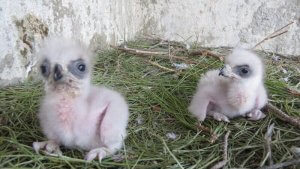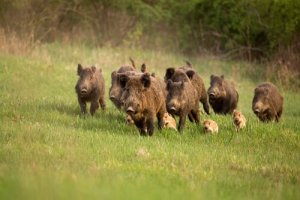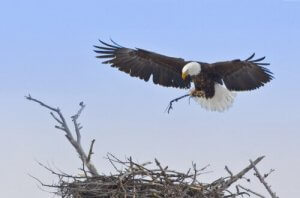What Are Wildlife Rehabilitation Centers?


Written and verified by the vet Érica Terrón González
Wildlife rehabilitation centers are places where sick, injured and orphaned creatures can be treated and cared for, with the aim of releasing them back into the wild once they are fully recovered.
What is the role of a wildlife center?
Wildlife centers perform a number of other roles, such as:
- Rescuing animals and making sure they receive veterinary treatment.
- The rehabilitation and release of these animals.
- The reintroduction and monitoring of endangered species.
- Hand-rearing and caring for orphaned animals.

- Monitoring epidemics.
- Working with wildlife conservation projects, education programs and raising awareness of environmental issues.
- Investigating suspicious deaths of wild animals.
In a wildlife center, everyone’s work overlaps, so it’s important for each member of the team to work together.

What else do wildlife rehabilitation centers do?
- Some centers take part in captive breeding programs designed to help boost endangered species.
- Others set up fostering programs to help cover care costs.
- Some analyze samples taken from species they have treated.
- Others conduct surveys, help to maintain and care for green spaces, and work to preserve vital habitat.
On top of all that, centers also devote themselves to raising awareness and teaching the public about species which might be “at odds” with humans, in an attempt to improve their relationship. They also help to educate the general public about environmental issues, and manage local wildlife.
Wildlife rehabilitation centers: facilities
Most of the materials, equipment and drugs used by rehab centers are often donated to them by other wildlife groups. Ideally, most centers need:
- An administration block – where rescuers leave new patients and report any findings to the medical team, which is in charge of collecting them for treatment.
- A sick bay, where every patient will receive treatment.
As well as medical information, wildlife centers are a source of daily information for all kinds of studies involving wild animals.

Equipment and facilities
- X-ray and ultra-sound machines.
- Pre-op room: where they keep surgical equipment and other materials.
- Operating theater with an anesthesia machine and monitors.
- Autopsy room.
- Laboratory – both on and offsite.
- A reptile room– while most of the creatures that arrive at wildlife centers are mammals and birds, they must also install specialist wings for other types of patients.
- Storage – much of the wildlife staying at these centers need “live food” which requires its own special facilities.
The rest of the center will be made up of cages where staff can keep a close eye on their patients. These include larger pens where treatment can continue once any injuries have healed. In the case of birds of prey, they will also need a wide open space where they can learn to fly again.

Each country or region will have its own specific needs. For example, central states won’t need marine life facilities, while coastal regions will.
Wildlife rehabilitation centers are places where sick, injured and orphaned creatures can be treated and cared for, with the aim of releasing them back into the wild once they are fully recovered.
What is the role of a wildlife center?
Wildlife centers perform a number of other roles, such as:
- Rescuing animals and making sure they receive veterinary treatment.
- The rehabilitation and release of these animals.
- The reintroduction and monitoring of endangered species.
- Hand-rearing and caring for orphaned animals.

- Monitoring epidemics.
- Working with wildlife conservation projects, education programs and raising awareness of environmental issues.
- Investigating suspicious deaths of wild animals.
In a wildlife center, everyone’s work overlaps, so it’s important for each member of the team to work together.

What else do wildlife rehabilitation centers do?
- Some centers take part in captive breeding programs designed to help boost endangered species.
- Others set up fostering programs to help cover care costs.
- Some analyze samples taken from species they have treated.
- Others conduct surveys, help to maintain and care for green spaces, and work to preserve vital habitat.
On top of all that, centers also devote themselves to raising awareness and teaching the public about species which might be “at odds” with humans, in an attempt to improve their relationship. They also help to educate the general public about environmental issues, and manage local wildlife.
Wildlife rehabilitation centers: facilities
Most of the materials, equipment and drugs used by rehab centers are often donated to them by other wildlife groups. Ideally, most centers need:
- An administration block – where rescuers leave new patients and report any findings to the medical team, which is in charge of collecting them for treatment.
- A sick bay, where every patient will receive treatment.
As well as medical information, wildlife centers are a source of daily information for all kinds of studies involving wild animals.

Equipment and facilities
- X-ray and ultra-sound machines.
- Pre-op room: where they keep surgical equipment and other materials.
- Operating theater with an anesthesia machine and monitors.
- Autopsy room.
- Laboratory – both on and offsite.
- A reptile room– while most of the creatures that arrive at wildlife centers are mammals and birds, they must also install specialist wings for other types of patients.
- Storage – much of the wildlife staying at these centers need “live food” which requires its own special facilities.
The rest of the center will be made up of cages where staff can keep a close eye on their patients. These include larger pens where treatment can continue once any injuries have healed. In the case of birds of prey, they will also need a wide open space where they can learn to fly again.

Each country or region will have its own specific needs. For example, central states won’t need marine life facilities, while coastal regions will.
All cited sources were thoroughly reviewed by our team to ensure their quality, reliability, currency, and validity. The bibliography of this article was considered reliable and of academic or scientific accuracy.
- Patrimonio Natural de Castilla y León [Internet]. org. [cited 25 September 2019]. Available from: https://patrimonionatural.org/paginas/cras/los-centros-de-recuperacion-y-recepcion-de-animales-silvestres
- Centros de recuperación de fauna en España [Internet]. [cited 25 September 2019]. Available from: https://www.grefa.org/esta-en-tu-mano/centros-de-recuperacion-de-fauna-en-espana
This text is provided for informational purposes only and does not replace consultation with a professional. If in doubt, consult your specialist.








